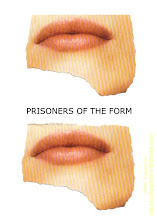
lunedì 7 marzo 2011
Iscriviti a:
Commenti sul post (Atom)
Every page is constructed in the way to have its complete autonomy, but also to be part of a whole. Every single page presumes their whole, the whole refers to a part, and in this game of mirrors between the center and the periphery, you can find the completion of its representation. Their sequences should give the effect of unique pieces entering in a plot that has been developing almost in concentric circles, joining apparently distant realties, separated by language differences. So, the individual dimension enters the social, and the social wanders towards an unreachable distance.
It is like moving oneself all along rings in a superimposition of states not depending on the point of observation that becomes progressively unreachable, removed nearly on another planet or an indefinite point of the space and then coming back for reconnection. The continuous movements repair like a fracture, every piece of broken reality inside the confusion of languages appears like an image produced by a temporal dissociation. In a temporal dissociation, information are widespread and are perceived in a distorted way, you have to distinguish what is original from what is transmitted, like before or after or cause/effect, what is our from what is not.
Thus, sentenced to live almost in a deferred form in time, everyone knows just a piece of a story. The possibility to redesign the full painting, to reconstruct the memory could occur in an attempt to reconnect the fragments of an undifferentiated universe where the real and unreal, visible and invisible are mixed. The method, the possibility is to follow the elementary principle of an analog association, that has its forerunner in Burroughs' "cut-up" trilogy. The initially incomplete writing evokes an image, joins with it, becomes an image itself, continuously constructing and deconstructing reflections, illusory games, to be identified with. The
In essence, the Book Pages synthesizes taking information from newspapers or the first class elementary school notebooks; a model of a spaceship looking like an archaeological find of the future can be associated to the demolition of a quarter of Jenin in Palestine; and than, on another page “Escaping from New York” 1997, mirrors the social and urban condition risking to become more and more real, as it might be in Bunuel’s movie where a man shooting at passers-by from a skyscraper became part of the third millennium chronicle, almost anticipated it. Sentenced to ignorance, every connection between deferred information in time is like a tiny glimmer of light on the memory of an escaping underground plot, a search for an adhesion of two images in one, like an isle which sinks, once you have reached it.
Ogni pagina è costruita in modo che abbia una sua compiuta autonomia, ma essa è anche parte di un insieme. Ogni singola pagina presuppone il loro insieme, l’insieme rimanda al singolo, e in questo gioco di specchi tra centro e periferia, vi è il segno del completamento della sua rappresentazione. La messa in sequenza dovrebbe appunto dare il senso di come pezzi unici entrino in una trama che si sviluppa quasi per cerchi concentrici, collegando realtà apparentemente lontane, divise dalla separazione propria dei linguaggi. In questo modo la dimensione individuale entra nel sociale, e il sociale si dilata quasi in una visione a distanza. E’ come muoversi lungo anelli in una sovrapposizione di stati coincidenti, che si scindono col punto di osservazione che progressivamente diviene irraggiungibile, spostandosi quasi su un altro pianeta, o in un in punto indefinito nel cosmo, e poi tornano a ricompattarsi. Questo veloce movimento ricuce come una frattura, ogni pezzo di realtà frantumata nella confusione dei linguaggi, appare come una immagine prodotta da una dissociazione temporale. Nella dissociazione temporale le informazioni viaggiano e sono percepite nella distorsione di dividere ciò che ha origine da ciò che è che è trasmesso, come il prima e il dopo e la causa e l’effetto, ciò che ci appartiene e ciò che è estraneo.
Quindi, nella condanna a vivere quasi come in una forma differita nel tempo, ognuno conosce solo un pezzo della storia. La possibilità di ridisegnare il quadro completo, di ricostruirne la memoria, non può che avvenire cercando di mettere insieme i frammenti di un universo indifferenziato in cui reale e non reale, visibile e non visibile, si confondono. Il metodo, la possibilità, è seguire il principio elementare dell’associazione analogica, che vede il cut-up di Burroghs il precursore. La scrittura, nata incompiuta, chiama l’immagine, si combina con essa, diventa essa stessa immagine, nel continuo costruire e decostruire riflessi, giochi illusori, in cui riconoscersi. La caverna di Platone come la sala buia di un cinematografo, rompe lo schema dei corpi immateriali frutto di una finzione.
Le Pagine Libro, nella loro essenzialità, sintetizzano prelevando informazioni da pezzi di giornale o da quaderni di prima elementare; il modello di una l’astronave che sembra quasi il reperto di una archeologia del futuro è associato alla demolizione del quartiere di Jenin in Palestina; in un’altra pagina si va ancora più avanti, 1997 fuga da New York diventa lo specchio di una condizione sociale e urbana che rischia sempre di più di divenire reale, come potrebbe esserlo la sequenza del film di Bunuel dell’uomo che dall’alto di un grattacielo spara sui passanti lo è stato entrando nella cronaca della stessa grande metropoli nel terzo millennio, quasi anticipandola. Condannati a non sapere, ogni collegamento tra informazioni differite nel tempo, è come un barlume di luce su un ricordo di una trama sotterranea che sfugge, e la ricerca di adesione di due immagini in una sola immagine è come l’approdo ad un’isola che, una volta raggiunta, si inabissa.
Aldo Saracino (ALBAMUTH)


Nessun commento:
Posta un commento